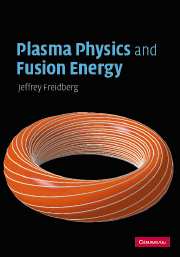Book contents
- Frontmatter
- Contents
- Preface
- Acknowledgements
- Units
- Part I Fusion power
- Part II The plasma physics of fusion energy
- 6 Overview of magnetic fusion
- 7 Definition of a fusion plasma
- 8 Single-particle motion in a plasma – guiding center theory
- 9 Single-particle motion – Coulomb collisions
- 10 A self-consistent two-fluid model
- 11 MHD – macroscopic equilibrium
- 12 MHD – macroscopic stability
- 13 Magnetic fusion concepts
- 14 Transport
- 15 Heating and current drive
- 16 The future of fusion research
- Appendix A Analytical derivation of 〈ς v〉
- Appendix B Radiation from an accelerating charge
- Appendix C Derivation of Boozer coordinates
- Appendix D Poynting's theorem
- Index
- References
8 - Single-particle motion in a plasma – guiding center theory
Published online by Cambridge University Press: 14 May 2010
- Frontmatter
- Contents
- Preface
- Acknowledgements
- Units
- Part I Fusion power
- Part II The plasma physics of fusion energy
- 6 Overview of magnetic fusion
- 7 Definition of a fusion plasma
- 8 Single-particle motion in a plasma – guiding center theory
- 9 Single-particle motion – Coulomb collisions
- 10 A self-consistent two-fluid model
- 11 MHD – macroscopic equilibrium
- 12 MHD – macroscopic stability
- 13 Magnetic fusion concepts
- 14 Transport
- 15 Heating and current drive
- 16 The future of fusion research
- Appendix A Analytical derivation of 〈ς v〉
- Appendix B Radiation from an accelerating charge
- Appendix C Derivation of Boozer coordinates
- Appendix D Poynting's theorem
- Index
- References
Summary
Introduction
A major goal of this book is to provide an understanding of how magnetic fields confine charged particles in a fusion plasma. As such, one would like to develop an intuition about the detailed behavior of particle orbits in self-consistent magnetic fields. In particular, it must be demonstrated that charged particles stay confined within the plasma and do not become lost drifting across the field and hitting the first wall.
As a first step towards this goal this chapter focuses on the motion of charged particles in prescribed magnetic and electric fields. No attempt is made at self-consistency – for example, to include the currents and corresponding induced magnetic fields resulting from the flow of charged particles. The fields are simply specified as known quantities. They are assumed to be smooth, slowly varying functions in order to be compatible with the requirement that plasmas be dominated by long-range collective effects. The question of self-consistent fields is deferred to future chapters after appropriate models have been developed.
In the process of studying single-particle motion it will become apparent that there is a well-separated hierarchy of frequencies that characterize the different types of motion that can occur. The fastest and dominant behavior corresponds to gyro motion in which particles move freely along magnetic field lines and rotate in small circular orbits perpendicular to the magnetic field. This motion provides perpendicular confinement of charged particles and makes a toroidal geometry necessary in order to avoid parallel losses.
- Type
- Chapter
- Information
- Plasma Physics and Fusion Energy , pp. 139 - 182Publisher: Cambridge University PressPrint publication year: 2007



